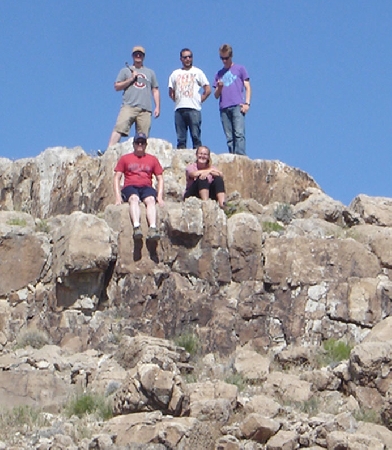University News
Geology Assistant Professor and Students Study Exceptionally Preserved Fauna from the Cambrian-Age Formation
September 16, 2015
MACOMB, IL – From May 31- June 11, Western Illinois University Assistant Professor of Paleontology Thomas Hegna and five of his geology students investigated a unique Cambrian-aged (approximately 500-million-year-old) fossil deposit in west-central Utah. The National Geographic Society Committee for Research and Exploration supported the team's fieldwork.
The five undergraduates included geology majors, senior Nick Liming (Lombard, IL), senior Hunter Starr (Elmhurst, IL), senior Corrin Kaffenburger (Peters) (Quincy, IL), senior Justin Christensen (Mokena, IL) and sophomore Andrew Turner (Western Springs, IL).
The students worked along with an international team of paleontologists that included researcher Rudy Lerosey-Aubril from the School of Environmental & Rural Science at the University of New England, associate professor Robert Gaines from Pomona College, research fellow Javier Ortega Hernández from Cambridge University and associate research scientist Peter Van Roy from Yale University.
Hegna and Lerosey-Aubril had been collaborating on this project for more than five years and were able to make this research trip a reality with help from National Geographic and several WIU undergraduate research grants, which supported a larger field party that included the students.
"The experience was an amazing opportunity because it was supported by National Geographic. I was lucky to be a part of it," said Kaffenburger. "At first I was intimidated to be working with all of these men who had a Ph.D., but I soon realized that they were very nice, and I was able to learn so much from them."
The group observed remains of many multicellular organisms that have been preserved since the Cambrian Explosion.
"After the Cambrian Explosion, we saw the first appearance of many multicellular groups of animals on Earth. After the explosion, the Ordovician Radiation event is when we saw a diversification of many of these original groups. Having a set of exceptionally preserved animals in-between those two major events is helping us connect those evolutionary lineages through time," said Hegna.
The group worked from dawn to dusk in hot, dry conditions with temperatures ranging from 80-90 degrees each day. They worked in quarries that had been previously opened, splitting rock while looking for specimens and going bed-by-bed trying to get into layers of rock where soft tissue was preserved.
"Normally, when people think of fossils, they think of shells or bones, but what is unique about our work is that we were finding preserved soft tissue—the parts that are not mineralized. We were finding remains of animals that did not have shells or bones, which is not normal, so this is a very unique deposit," said Hegna.
"It was very fun and interesting to go out and do fieldwork. I learned a lot compared to what I am limited to learning in a classroom. It took me three days to finally find any soft-tissue preservation, but the hard work paid off," said Christensen.
After gathering fossils of fauna in Utah, the team shipped the fossils back where they could study them at a later date.
"Even more common fossils, like the shells of trilobites, are unique. The specimens are preserved with silica in a limestone. By taking concentrated hydrochloric acid (HCl), we are able to dissolve away everything that's not preserved by silica, leaving only the fossil, which allows us to examine it in better detail," said Liming.
"I am extremely interested in continuing my education after earning a bachelor's degree, and this was my first time out in the field. I really got a sense of what it is like going out and collecting specimens as well as learning what kind of fieldwork is necessary to gather the specimens needed for studies in the area I'm interested in, which is paleontological sciences," said Starr.
Hegna and the students will continue to study the fauna and hope to be able to take another trip in the future.
"We are very lucky that Dr. Hegna advocated for his students to be a part of this trip because we were the only students on this project, and it was a great opportunity," said Kaffenburger. "Being able to work with my hands and work with people who are very passionate about what they do helped me realize what I can do with my geology degree after graduation, and I'm very excited for that."
Posted By: Caitlin Meyers (WIUNews@wiu.edu)
Office of University Communications & Marketing


Connect with us: